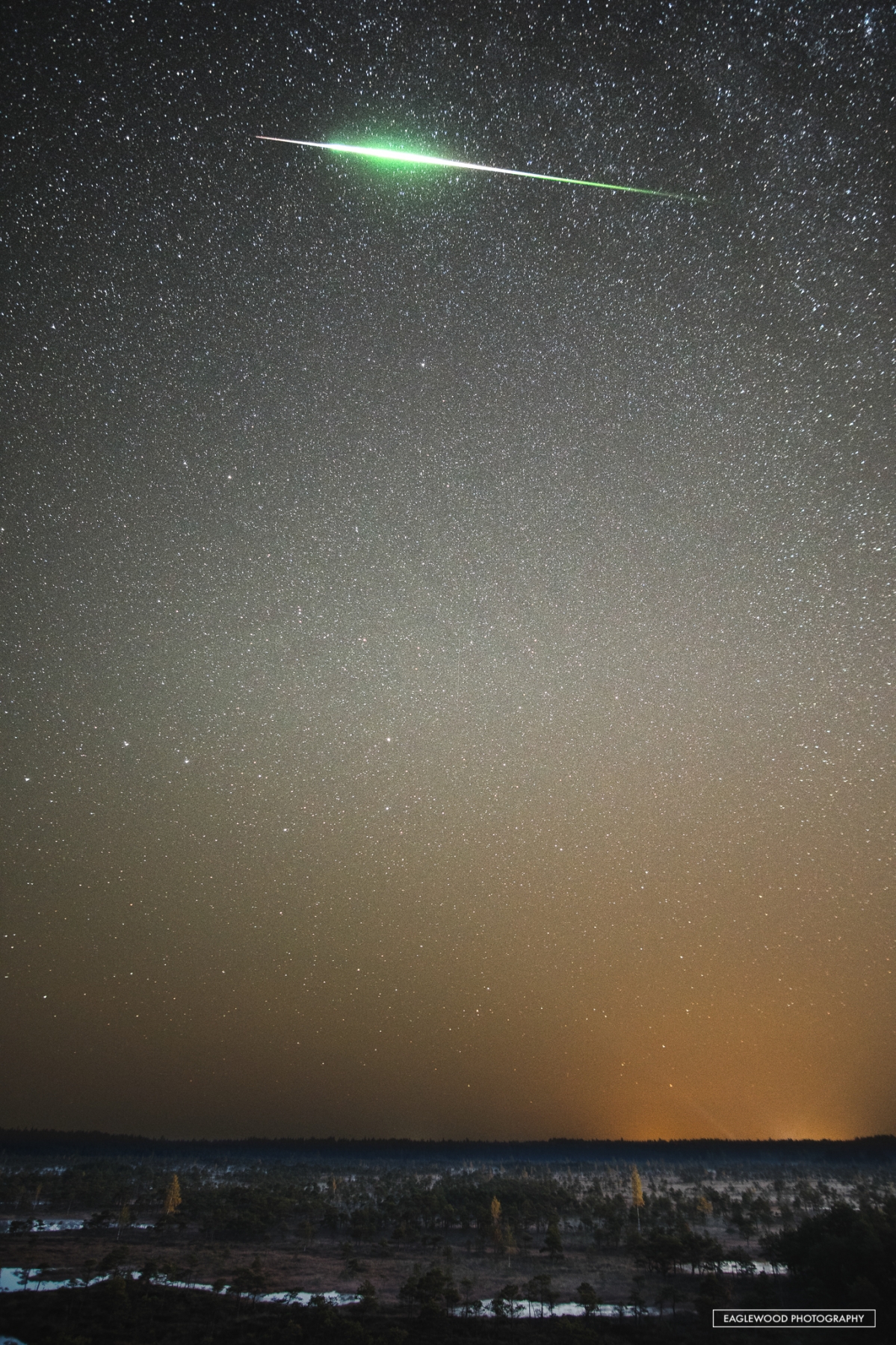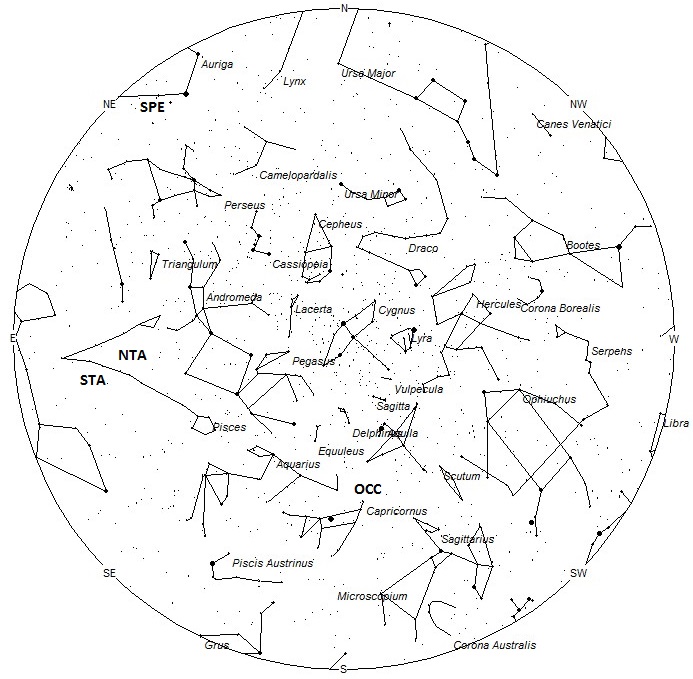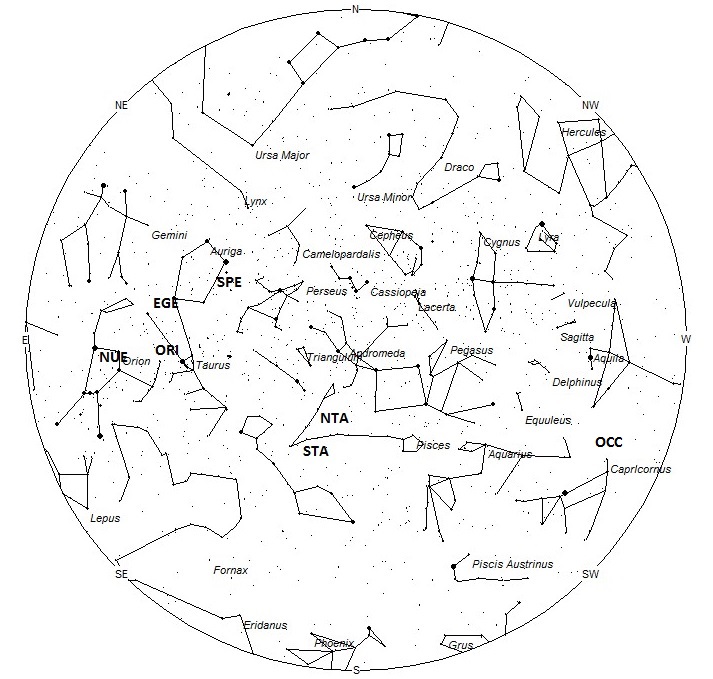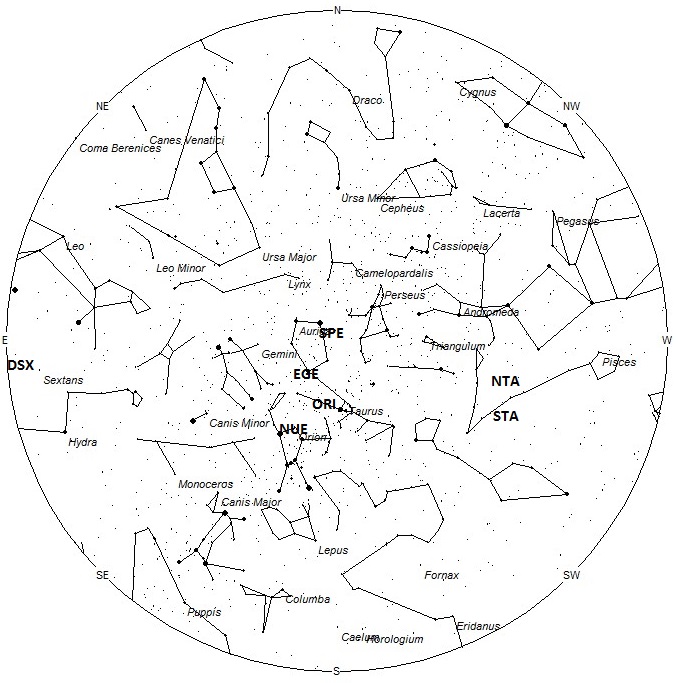
During this period the moon will reach its full phase on Thursday October 5th. At this time the moon will be located opposite the sun and will lie above the horizon all night long. This weekend the waxing gibbous moon will set during the early morning hours, allowing meteor observers a few hours of dark skies before the first light of dawn. The estimated total hourly meteor rates for evening observers this week is near 3 for those viewing from the northern hemisphere and 2 for those located south of the equator. For morning observers the estimated total hourly rates should be near 16 as seen from mid-northern latitudes and 13 from the southern tropics. The actual rates will also depend on factors such as personal light and motion perception, local weather conditions, alertness and experience in watching meteor activity. Evening rates are reduced this week due to moonlight. Note that the hourly rates listed below are estimates as viewed from dark sky sites away from urban light sources. Observers viewing from urban areas will see less activity as only the brighter meteors will be visible from such locations.
The radiant (the area of the sky where meteors appear to shoot from) positions and rates listed below are exact for Saturday night/Sunday morning September 30/October 1. These positions do not change greatly day to day so the listed coordinates may be used during this entire period. Most star atlases (available at science stores and planetariums) will provide maps with grid lines of the celestial coordinates so that you may find out exactly where these positions are located in the sky. A planisphere or computer planetarium program is also useful in showing the sky at any time of night on any date of the year. Activity from each radiant is best seen when it is positioned highest in the sky, either due north or south along the meridian, depending on your latitude. It must be remembered that meteor activity is rarely seen at the radiant position. Rather they shoot outwards from the radiant so it is best to center your field of view so that the radiant lies at the edge and not the center. Viewing there will allow you to easily trace the path of each meteor back to the radiant (if it is a shower member) or in another direction if it is a sporadic. Meteor activity is not seen from radiants that are located far below the horizon. The positions below are listed in a west to east manner in order of right ascension (celestial longitude). The positions listed first are located further west therefore are accessible earlier in the night while those listed further down the list rise later in the night.
These sources of meteoric activity are expected to be active this week.
.
Experienced observers are urged to be on the lookout for any activity from the October Capricornids (OCC). These meteors are possibly related to lost comet D/1978 R1 (Haneda-Campos). If the comet still exists it would have reached perihelion in November 2016. A moderate display of bright meteors was seen from Australia on October 3, 1972. Other attempts at observing these meteors were less successful. Moonlight will interfere during this period but observers are still urged to monitor the evening sky this week for any very slow meteors radiating from the border of Capricornus and Aquila near the position 20:12 (303) -10. This position is roughly 4 degrees northwest of the naked eye double star known as Algedi (alpha2 Capricorni). This position is best placed near 2000 (8pm) local daylight saving time (LDT) when the radiant lies highest above the horizon. While this area of the sky is fairly well placed for northern observers, it is much more favorably placed for those south of the equator where it lies much higher in the sky. Like the Daytime Sextantids mentioned below, any observations of these stream (either positive or negative) would be important to our understanding of these streams. Maximum activity is predicted to occur on October 2nd.
Recent data from the worldwide CAMS network has suggested that the Northern Taurids (NTA) may be active much earlier than expected. We do not normally look for these meteors until October 20th but they may be active as early as September 23. Please look for these slow meteors coming from a large radiant centered at 01:04 (016) +12. This area of the sky is located in central Pisces, 4 degrees north of the faint star known as epsilon Piscium. This position is also close to the Southern Taurids so great care must be taken in separating these meteors. You must have the two radiants near the center of your field of view to properly differentiate these sources. The maximum is not expected until early November so current rates would be 1 per hour or less. These meteors may be seen all night long but the radiant is best placed near 0200 LDT when it lies on the meridian and is located highest in the sky. With an entry velocity of 28 km/sec., the average Southern Taurid meteor would be of slow velocity.
The Southern Taurids (STA) are active from a large radiant centered near 01:20 (020) +06. This position lies in southeastern Pisces, 2 degrees southeast of the faint star known as zeta Piscium. These meteors may be seen all night long but the radiant is best placed near 0200 LDT when it lies on the meridian and is located highest in the sky. Rates at this time should be near 3 per hour regardless of your location. With an entry velocity of 27 km/sec., the average Southern Taurid meteor would be of slow velocity.
The last of the September Epsilon Perseids (SPE) will be seen this week. The radiant is currently located at 04:49 (072) +41. This position lies on the Perseus/Auriga border, 3 degrees west of the 3rd magnitude star known as Haedus II (eta Aurigae). The radiant is best placed near 0500 LDT, when it lies highest above the horizon. Rates are expected to be less than 1 per hour no matter your location. With an entry velocity of 65 km/sec., most activity from this radiant would be swift.
The Orionids (ORI) are active from a radiant located at 04:57 (074) +17, which places it in central Taurus, 4 degrees east of the 1st magnitude orange star known as Aldebaran (alpha Tauri). This area of the sky is best placed in the sky during the last hour before dawn, when it lies highest above the horizon in a dark sky. Current rates would be near 2 per hour no matter your location. With an entry velocity of 67 km/sec., most activity from this radiant would be of swift speed.
Recent data from the worldwide CAMS network has also suggested that the epsilon Geminids (EGE) may be active now and peak earlier than previous suspected. If active, members of this shower would radiate from 05:32 (083) +28. This position lies in northeastern Taurus, 2 degrees southeast of the 2nd magnitude star known as Elnath (beta Tauri). This area of the sky is best seen during the last dark hour before dawn when the radiant lies highest in a dark sky. Expected hourly rates would be less than 1 per hour no matter your location. With an entry velocity of 70 km/sec., the average meteor from this source would be of swift velocity.
The nu Eridanids (NUE) were co-discovered by Japanese observers using SonotoCo and Juergen Rendtel and Sirko Molau of the IMO. Activity from this long-period stream stretches from August 24 all the way to November 16. A very shallow maximum occurred near September 8. The radiant currently lies at 05:35 (084) +08, which places it in western Orion, 3 degrees northeast of the 2nd magnitude star known as Bellatrix (gamma Orionis). This area of the sky is best seen during the last dark hour before dawn when the radiant lies highest in a dark sky. Current rates are expected to be near 1 per hour during this period no matter your location. With an entry velocity of 67 km/sec., the average meteor from this source would be of swift velocity. Some experts feel that these meteors are early members of the Orionid shower, which peaks on October 22.
The Daytime Sextantids (DSX) are not well known due to the fact that the radiant lies close to the sun and these meteors are only visible during the last couple of hours before dawn. The radiant is currently located at 10:24 (156) -02. This position lies in central Sextans, 4 degrees southeast of the 4th magnitude star known as alpha Sextantis. This area of the sky is best placed in the sky during the last hour before dawn, when it lies highest above the horizon in a dark sky. Current rates would be most likely less than 1 per hour no matter your location. Spotting any of this activity would be a notable accomplishment. With an entry velocity of 33km/sec., most activity from this radiant would be of medium-slow speed.
As seen from the mid-northern hemisphere (45N) one would expect to see approximately 10 sporadic meteors per hour during the last hour before dawn as seen from rural observing sites. Evening rates would be near 2 per hour. As seen from the tropical southern latitudes (25S), morning rates would be near 7 per hour as seen from rural observing sites and 1 per hour during the evening hours. Locations between these two extremes would see activity between the listed figures. Evening rates are reduced this week due to moonlight.
The list below offers the information from above in tabular form. Rates and positions are exact for Saturday night/Sunday morning except where noted in the shower descriptions.
| SHOWER | DATE OF MAXIMUM ACTIVITY | CELESTIAL POSITION | ENTRY VELOCITY | CULMINATION | HOURLY RATE | CLASS |
| RA (RA in Deg.) DEC | Km/Sec | Local Daylight Saving Time | North-South | |||
| October Capricornids (OCC) | Oct 02 | 20:12 (303) -10 | 10 | 20:00 | <1 – <1 | IV |
| Northern Taurids (NTA) | Nov 02 | 01:04 (016) +12 | 28 | 02:00 | 1 – 1 | II |
| Southern Taurids (STA) | Oct 29-Nov 03 | 01:20 (020) +06 | 27 | 02:00 | 3 – 3 | II |
| September Epsilon Perseids (SPE) | Sep 10 | 04:49 (072) +41 | 65 | 05:00 | <1 – <1 | II |
| Orionids (ORI) | Oct 22 | 04:57 (074) +17 | 67 | 05:00 | 2 – 2 | I |
| epsilon Geminids (EGE) | Oct 11 | 05:32 (083) +28 | 70 | 06:00 | <1 – <1 | II |
| nu Eridanids (NUE) | Sep 08 | 05:35 (084) +08 | 67 | 06:00 | 1 – 1 | IV |
| Daytime Sextantids (DSX) | Sep 29 | 10:24 (156) -02 | 33 | 11:00 | <1 – <1 | IV |
 American Meteor Society
American Meteor Society



Hello,
I am hearing rumors that a meteor shower could’ve started the multiple (Napa, Sonoma and surrounding counties in Northern California) wildfires do you believe this May be possible?
I have not seen any evidential news coverage on this, just people talking. Someone commented that some kids are saying that they saw a meteor hit Atlas Peak Road (Napa, Ca) right before the fire started. Many fires started around the same times in various different locations and I have seen some YouTube videos theorizing that it’s possible due to recent Made here reporting’s in the area, but there’s not been anything saying that Meteors caused the fires.
Margie and All,
Meteors did not cause these fires. It is a common misconception that meteors are on fire when they reach the ground. This is simply not true. When meteors encounter the atmosphere they begin to slow down to a velocity of about 300 mph at around 5 miles altitude. From that altitude the meteor basically free falls and cools while doing so. Meteorites (meteors that have reached the ground) may be warm to the touch but are certainly well below the point to cause ignition and fires. This is all speculating that a meteor actually reached the ground. This is a very rare occurrence and nearly all meteors completely disintegrate while still very high in the atmosphere. Any meteor reaching the ground would have been seen and/or heard by hundreds of people. There are no reports in our database to associate with the start of these fires.
I hope this helps!
Robert Lunsford